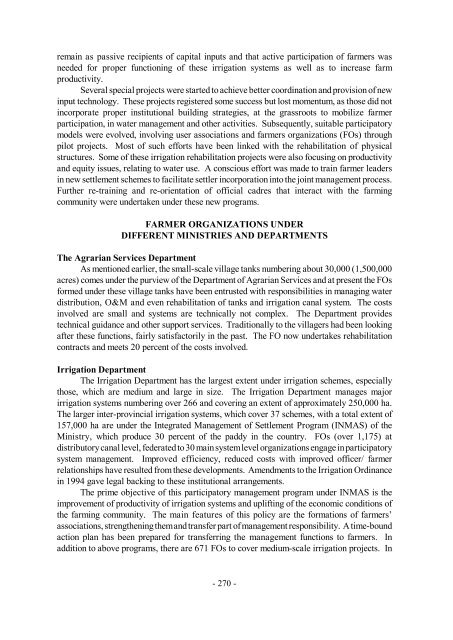Organizational Change for Participatory Irrigation Management
Organizational Change for Participatory Irrigation Management
Organizational Change for Participatory Irrigation Management
You also want an ePaper? Increase the reach of your titles
YUMPU automatically turns print PDFs into web optimized ePapers that Google loves.
emain as passive recipients of capital inputs and that active participation of farmers was<br />
needed <strong>for</strong> proper functioning of these irrigation systems as well as to increase farm<br />
productivity.<br />
Several special projects were started to achieve better coordination and provision of new<br />
input technology. These projects registered some success but lost momentum, as those did not<br />
incorporate proper institutional building strategies, at the grassroots to mobilize farmer<br />
participation, in water management and other activities. Subsequently, suitable participatory<br />
models were evolved, involving user associations and farmers organizations (FOs) through<br />
pilot projects. Most of such ef<strong>for</strong>ts have been linked with the rehabilitation of physical<br />
structures. Some of these irrigation rehabilitation projects were also focusing on productivity<br />
and equity issues, relating to water use. A conscious ef<strong>for</strong>t was made to train farmer leaders<br />
in new settlement schemes to facilitate settler incorporation into the joint management process.<br />
Further re-training and re-orientation of official cadres that interact with the farming<br />
community were undertaken under these new programs.<br />
FARMER ORGANIZATIONS UNDER<br />
DIFFERENT MINISTRIES AND DEPARTMENTS<br />
The Agrarian Services Department<br />
As mentioned earlier, the small-scale village tanks numbering about 30,000 (1,500,000<br />
acres) comes under the purview of the Department of Agrarian Services and at present the FOs<br />
<strong>for</strong>med under these village tanks have been entrusted with responsibilities in managing water<br />
distribution, O&M and even rehabilitation of tanks and irrigation canal system. The costs<br />
involved are small and systems are technically not complex. The Department provides<br />
technical guidance and other support services. Traditionally to the villagers had been looking<br />
after these functions, fairly satisfactorily in the past. The FO now undertakes rehabilitation<br />
contracts and meets 20 percent of the costs involved.<br />
<strong>Irrigation</strong> Department<br />
The <strong>Irrigation</strong> Department has the largest extent under irrigation schemes, especially<br />
those, which are medium and large in size. The <strong>Irrigation</strong> Department manages major<br />
irrigation systems numbering over 266 and covering an extent of approximately 250,000 ha.<br />
The larger inter-provincial irrigation systems, which cover 37 schemes, with a total extent of<br />
157,000 ha are under the Integrated <strong>Management</strong> of Settlement Program (INMAS) of the<br />
Ministry, which produce 30 percent of the paddy in the country. FOs (over 1,175) at<br />
distributory canal level, federated to 30 main system level organizations engage in participatory<br />
system management. Improved efficiency, reduced costs with improved officer/ farmer<br />
relationships have resulted from these developments. Amendments to the <strong>Irrigation</strong> Ordinance<br />
in 1994 gave legal backing to these institutional arrangements.<br />
The prime objective of this participatory management program under INMAS is the<br />
improvement of productivity of irrigation systems and uplifting of the economic conditions of<br />
the farming community. The main features of this policy are the <strong>for</strong>mations of farmers’<br />
associations, strengthening them and transfer part of management responsibility. A time-bound<br />
action plan has been prepared <strong>for</strong> transferring the management functions to farmers. In<br />
addition to above programs, there are 671 FOs to cover medium-scale irrigation projects. In<br />
- 270 -
















